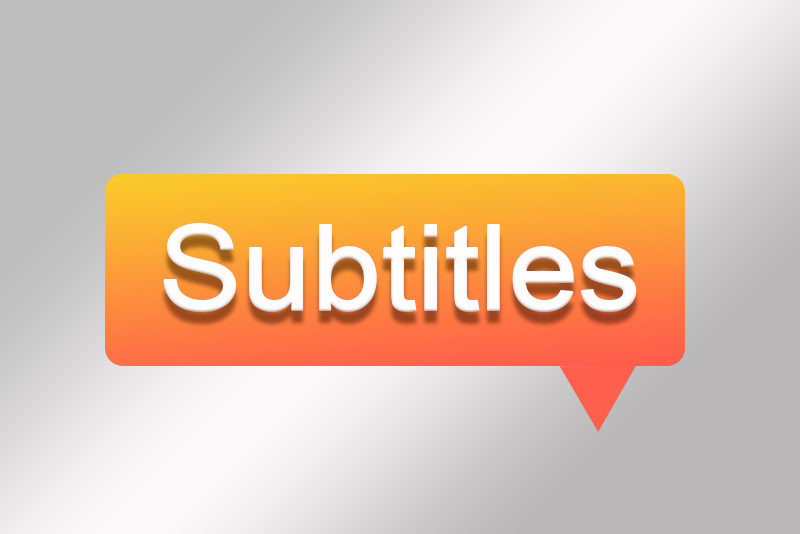Video captions and subtitles play an important role in communication by providing access to video content for all audiences, especially individuals with diverse language and accessibility needs. Digital transcription services are a key tool for creating captions and subtitles. Transcripts provide the textual content that is synchronized with the audio or video to enhance comprehension, accessibility, and engagement for viewers.
Captions vs. Subtitles
Before we explore how captions and subtitles enhance communication, let’s take a look at how they are different. In fact, this is important to determine the most appropriate choice for your video content.
Captioning
Captions offer a written representation of a video’s spoken words, sound effects, and music. They are designed to provide assistance to individuals who are deaf or hard of hearing. Research has demonstrated that captions offer valuable support for a diverse range of learners, including those who are English language learners, students with learning disabilities, and individuals who are new to a particular field and may not be familiar with specialized terminology.
By default, captions display as white text within a black background, though customization options may be available to viewers, depending on the viewing platform. The placement of captions varies but is commonly centered at the bottom of the screen for optimal readability. In instances where graphics or text occupies the lower third of the video, captions are usually positioned at the top of the screen.
Live event captioning is carried out in real-time, with a remote individual listening in via the internet (using platforms like Skype) or a phone. They deliver the transcribed text promptly and it is displayed on a projected screen, TV, or the audience’s mobile devices.
Subtitles
Subtitles primarily serve the purpose of translating dialogue for viewers who speak a different language. While captions encompass all dialogue and include descriptions of sound effects, the genre of music being played, and indications of accents if present, subtitles generally assume that the audience can hear background sounds, music, and non-verbal elements. The one exception to this rule is subtitles designed for the deaf and hard of hearing, which presume that the viewer cannot hear the audio or comprehend the spoken language.
Subtitles come in various styles, often white or yellow text with black outline or a black dropshadow, resembling captions. They’re usually centered at the screen’s bottom for readability and translation. When there’s lower-third content, subtitles go just above it. Customization depends on the viewing platform.
Why do Video Captions and Subtitles Matter?
Here are some key aspects of the role of video captions and subtitles in communication:
- Accessibility: Captions and subtitles make multimedia content accessible to viewers who are deaf or hard of hearing and those who may not understand the language spoken in the video or audio.
- Enhanced comprehension: By providing a visual reference to the spoken words, captions and subtitles can improve comprehension for or all viewers, including those with no hearing impairment. They provide textual reinforcement of spoken dialogue, making it easier for all audiences to follow complex conversations, accents, or fast-paced speech.
- Learning and education: Captions and subtitles are valuable tools in educational settings. They can improve focus and support language learning by allowing viewers to read and hear words simultaneously. By providing a written representation of spoken words, captions help students better understand and retain information presented in videos or lectures.
- International communication: Captions and subtitles allow content to be easily translated into multiple languages, making it accessible to a global audience. They provide clarity for viewers when dealing with accents, dialects, or technical jargon. This is crucial for international communication, as it enables people from diverse linguistic backgrounds to understand and engage with the content.
- Accessibility in noisy environments: Many people watch videos on mobile devices in public spaces where audio is not ideal. Captions and subtitles enable viewers to enjoy content without disturbing others, making them more likely to engage with videos in settings where audio cannot be played aloud (e.g., libraries, public transport, or quiet offices). Captions and subtitles enable people to consume content without disturbing others or missing out on crucial information.
- SEO: Optimizing captions and subtitles in online content can improve search engine optimization (SEO). Search engines can index the text, making videos or content more easily discoverable through text-based searches.This can lead to higher organic traffic and engagement as more viewers find the content through relevant searches.
- Increased engagement:Including both captions and subtitles in content often leads to increased viewer engagement. This is because captions can draw attention to important points, enhance storytelling, and keep viewers engaged even in noisy or distracting environments. Viewers can choose whether to enable or disable captions and subtitles based on their preferences and needs. This flexibility enhances the overall viewing experience, leading to increased engagement as viewers can consume content in their preferred manner.
- Promotes inclusivity: By enabling individuals with hearing impairments and those who speak different language to comprehend the content, video captions promote inclusivity. By providing captions and subtitles content creators can ensure that everyone has equal access to information, demonstrating their commitment to inclusivity and diversity. Additionally, in educational settings, video captions support inclusivity by creating a positive learning environment where every student feels valued and included. This can help build a positive reputation and a broader, more engaged audience.
- Compliance and legal requirements: Some countries and regions have regulations that mandate the provision of captions or subtitles for certain types of content, particularly for broadcast television and online streaming platforms.
Choose the Right Option
Captioning falls into two categories: open and closed. Open captions are permanently embedded in the video stream, unalterable by users. Closed captions feature the same content but can be toggled on/off in the video player. Choosing between these options depends on factors like the audience, upload destination, the chosen video player/platform, and the accessibility features of the player. In most instances, closed captioning is the preferred choice. Captions and subtitles also offer opportunities for creativity and stylistic choices. Content creators can use different fonts, colors, and styles to match the tone or theme of the content.
How Transcription Services can Help
To create captions or subtitles from your audio or video recordings, it has to be converted into written text or transcripts. Accurate transcription is crucial for creating high-quality captions and subtitles. Utilizing media transcription services can ensure precise video transcriptions that capture the spoken words and context effectively. Digital transcription agencies can also facilitate the smooth incorporation of their transcriptions into captioning and subtitling processes, streamlining the process of adding captions or subtitles to videos.
Make your videos more engaging with accurate transcriptions, captions and subtitles!




